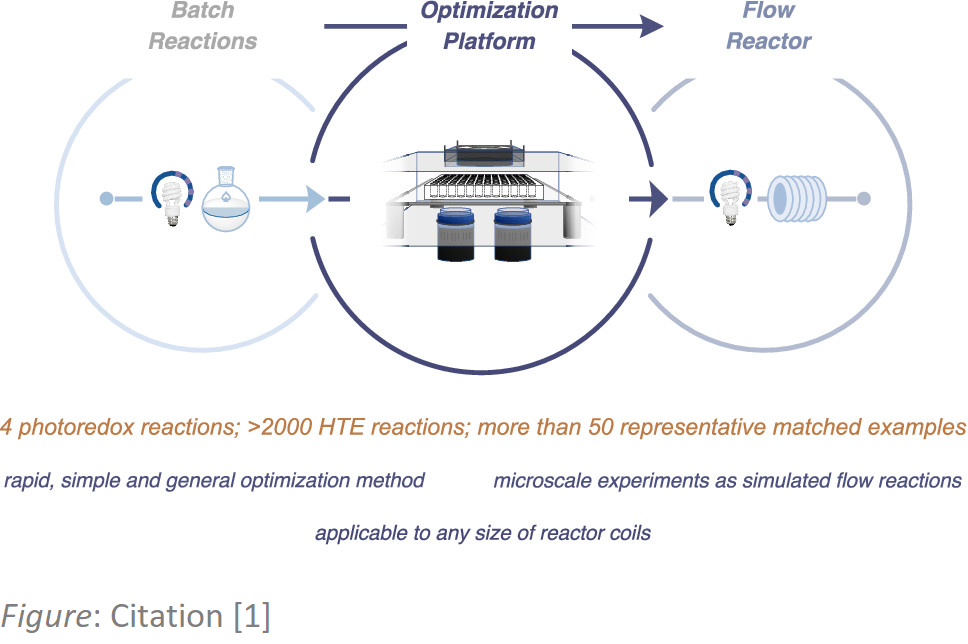
Date: 23 June 2021 | Category: News
ACS Central Science has published the paper entitled “Rapid Optimization of Photoredox Reactions for Continuous-Flow Systems Using Microscale Batch Technology”, in which Prof Dave W. C. MacMillan, in collaboration with Eli Lilly, explored photoredox catalysis using a Vapourtec photochemical reactor [1].
To speed reaction screening, MacMillan’s team developed a microscale platform to conduct high-throughput photochemical experiments, enabling them to rapidly identify suitable reaction conditions to scale in continuous flow. For most of their research, the team at Princeton University used a Vapourtec easy-Photochem. Thanks to its ease of use and exchangeable UV sources, with the same set-up, they could perform decarboxylative arylations irradiating 420 nm UV, or switching to a 385 nm UV source to undertake C-N arylations, allowing easy access to highly important intermediates for API development [1].
Photoredox catalysis – Creating new bonds with photons.
With the development of continuous flow, photochemistry and especially photoredox catalysis, has undergone a significant renaissance. Thanks to the uniform irradiation field of the UV-150 photochemical reactor and with the widest variety of UV wavelengths (220 to 600 nm), photochemical reactions are easily performed with Vapourtec.
Photoredox catalysts absorb light and use that energy to perform single electron transfer reactions with organic substrates, creating C-C, C-N or even C-O bonds. This reaction path has a greater atom efficiency than that achievable by traditional thermally mediated kinetics.
High-throughput experimentation
To speed screening of hundreds of reaction conditions, MacMillan’s team developed a batch set-up (FLOSIM HTE) that mimics the uniform irradiation field of the UV-150 photochemical reactor. Based on the results generated with this set-up, they could predict the yield of reactions such as decarboxylative arylation, C-N arylation, cross-electrophile coupling and C-O arylation in continuous flow.
Dr Manuel Nuño of Vapourtec commented: “The paper that the MacMillan group has published is another remarkable piece of work, accessing relevant compounds in an easy way. Before the development of the UV-150 Photochemical reactor in 2015, photoredox chemistry was performed in small vials [2]–[4] as the irradiation field is more uniform throughout the solution. Building from this experience, the team at Princeton developed a high-throughput system based on small batch reactors. With this set-up, they could quickly screen reaction conditions in batch. These results were then used to predict the outcome of flow reactions, transferring only the successful protocols into the E-Series.
“I find it remarkable the MacMillan team achieved a throughput of 26.6 g/day using our standard 450 nm LED light source. This work was completed before the launch of our family of High Power (HP) LED, these HP light sources provide up to 4 times the radiant power and are compatible with both R-Series or E-Series, which would yield over 100 g of compound a day!”
References
[1] M. González-Esguevillas et al., “Rapid Optimization of Photoredox Reactions for Continuous-Flow Systems Using Microscale Batch Technology,” ACS Cent. Sci., Jun. 2021
[2] J. A. Terrett, J. D. Cuthbertson, V. W. Shurtleff, and D. W. C. MacMillan, “Switching on elusive organometallic mechanisms with photoredox catalysis,” Nature, vol. 524, no. 7565, pp. 330–334, 2015
[3] D. Hager and D. W. C. Macmillan, “Activation of C-H bonds via the merger of photoredox and organocatalysis: A coupling of benzylic ethers with schiff bases,” J. Am. Chem. Soc., vol. 136, no. 49, pp. 16986–16989, 2014
[4] C. K. Prier and D. W. C. MacMillan, “Amine α-heteroarylation via photoredox catalysis: a homolytic aromatic substitution pathway,” Chem. Sci., vol. 5, no. 11, pp. 4173–4178, 2014
To read the paper featured in this news article click here
To read more about the UV-150 photochemical reactor click here
